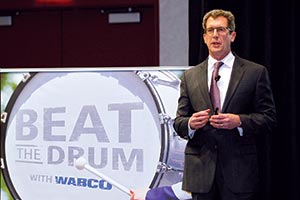Managing Editor, Features and Multimedia
Wabco, Bendix Say Active Safety Tech Paving Way for Autonomous Systems

This story appears in the April 11 print edition of Transport Topics.
LOUISVILLE, Ky. — The continuing evolution of active safety and braking systems is helping to pave the way for more advanced autonomous driving technologies, executives with two key industry suppliers said here at the Mid-America Trucking Show.
Jon Morrison, Wabco Holdings president of the Americas, said the improved stopping distance provided by air disc brakes over traditional drum brakes will be crucial for systems such as platooning, where two or more trucks connect wirelessly to synchronize braking and enable shorter following distances.
“We believe the disc brake will become a platform to enable the better braking that’s really going to be required when we look at future automation and future autonomous vehicles,” he said during a March 31 press conference.
COMPLETE COVERAGE: 2016 Mid-America Trucking Show
Wabco also introduced the next generation of its lane-departure warning system.
The latest version of the company’s OnLane system will add video-based data analytics through a partnership with SmartDrive, a supplier of onboard cameras and video safety technology.
That integration will enable fleets to coach their drivers to improve safety and efficiency, Morrison said.
Fred Andersky, director of customer solutions at Bendix Commercial Vehicle Systems, also discussed the continued refinement and growing market acceptance of active safety technology in an interview with Transport Topics during MATS.
“As we’re headed down the path to autonomous vehicles, that path is going to be built on advancing driver- assistance systems,” he said.
The active safety technology of tomorrow will incorporate data not only from sensors on the truck, but also from outside of the vehicle, Andersky said.
Vehicle-to-vehicle and vehicle-to- infrastructure communications will bring more information into the system to help it better react to a variety of events, including weather and traffic conditions, pedestrians in a crosswalk or a sharp turn in the road ahead.
However, the deployment of V2V and V2I systems would need to reach critical mass within the nation’s vehicle population to be effective, Andersky said. That likely would require a federal mandate of the technology.
“In order to really make this happen, there is going to be a need for a coordinated effort between government, industry and manufacturing,” he said.
Meanwhile, Wabco announced that it has sold more than 100,000 of its OnGuard collision mitigation systems in North America since the product’s launch in late 2007.
Last year, the company introduced the latest version of that system, OnGuardActive, which soon will be implemented for the first time by a U.S. fleet, Morrison said. Wabco often operates in North America through its joint venture with Meritor Inc., which is known as Meritor Wabco.
At the same time, Wabco has seen more than 60% year-over-year growth in its disc brake line in the past few years, Morrison added.
To help meet that demand, Wabco will soon begin manufacturing disc brakes in North America. The company’s new plant in Charleston, South Carolina, is on track to begin production by the third quarter, Morrison said.
The new version of the company’s OnLane system with video analysis will be available for order in late 2016, he said.
Bendix’s Andersky traced the development of active safety technology back to the introduction of anti-lock braking systems in 1996.
“We did something that hadn’t been done to the vehicle in 100 years. We added brains and eyes” to mechanical systems, he said.
With the addition of sensors, radar and cameras, today’s active safety technology such as Bendix’s Wingman Fusion system can provide forward collision mitigation and lane departure monitoring.
Looking ahead, a logical next step will be to add steering control, which will start to transform lane-departure systems into lane-keeping systems. With some additional cameras, the technology can evolve into an autopilot system.
But even then, the driver probably will still need to be engaged.
The industry is still a long way off from driverless trucks, Andersky said, adding that the driver will remain an important part of the safety equation.
Major truck makers, including Daimler, Volvo and Paccar, have demonstrated trucks with autonomous assistance, not driverless vehicles.
“Even as we get to more autonomous systems, they’re still driver- assistance systems. They’re not driver replacement systems. The driver is still integral.” Andersky said. “We need to do more to get the driver excited about the technology and not view it as a threat.”
Despite the increasing sophistication of Bendix’s active safety systems, the company’s braking technology remains an integral part of that business, Andersky said.
“We need to be able to optimize braking capability,” he said. “That integration with the wheel-end is still important and still makes it a whole system.”
Associate News Editor Jonathan S. Reiskin contributed to this story.

